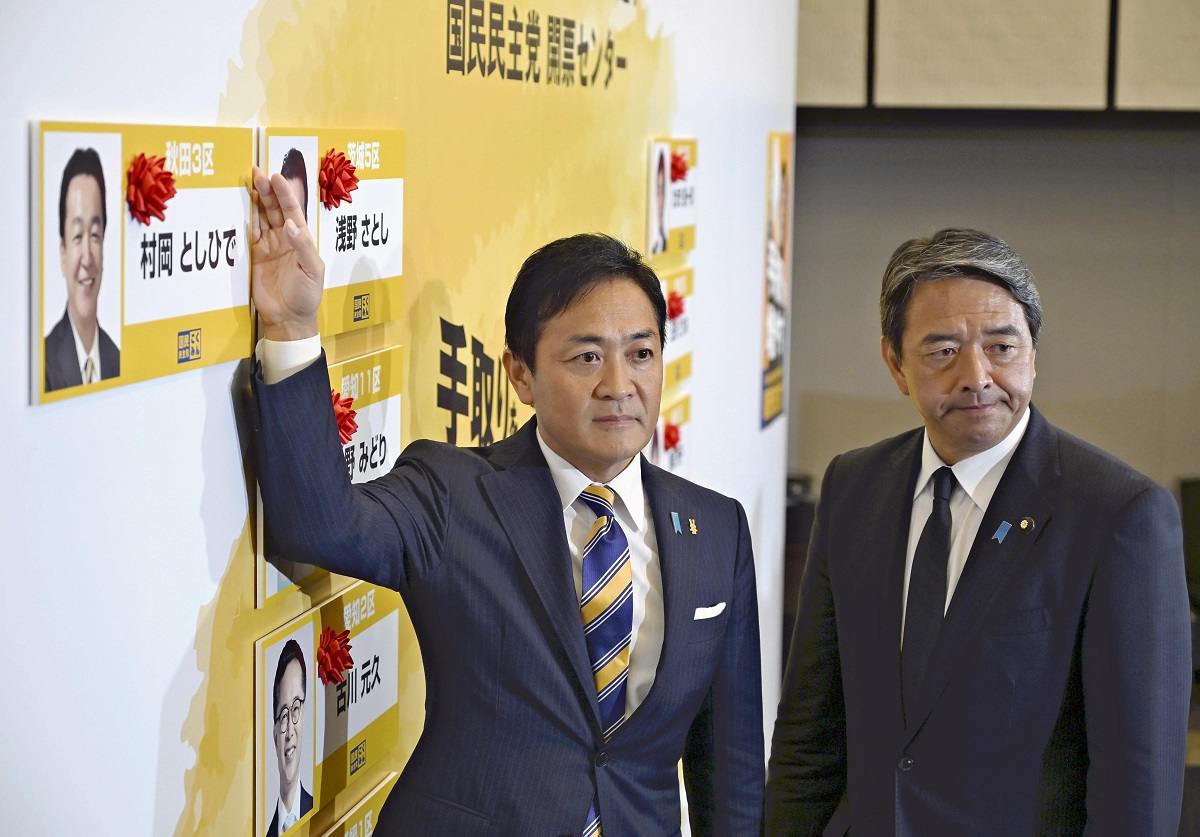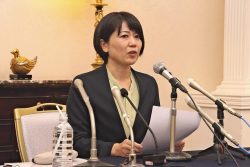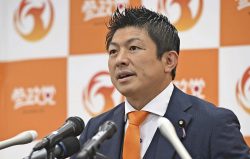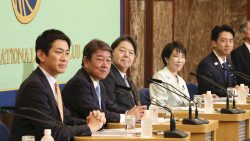Japan Election: DPFP’s Realism Helped Power Its Surge in Lower House; Party Won More Seats Than It Had Candidates

Democratic Party for the People leader Yuichiro Tamaki, left, and the party’s secretary general Kazuya Shinba pose for a photo at a ballot counting center in Shinjuku Ward, Tokyo, on Sunday.
16:13 JST, October 28, 2024
Key members of the Democratic Party for the People all handily won seats in their constituencies, including party leader Yuichiro Tamaki in Kagawa Constituency No. 2 and Diet affairs chief Motohisa Furukawa in Aichi Constituency No. 2.
The DPFP had a strong showing in the proportional representation segment as well, and increased its total seat count in the lower house from seven before the dissolution of the lower house to 28. A party with 21 or more seats can submit bills on its own.
“We said we would increase after-tax pay, that we would reduce social insurance premiums, and the people have entrusted us with their wish to see these things get done,” Tamaki said on an online show on Sunday evening.
In the election, the party stressed economic policies with a focus on support for households, saying it would reduce the consumption tax to 5% and cut income taxes and utility costs. The party also said it would increase after-tax pay for working people. As for the Liberal Democratic Party’s problem with money in politics, the DPFP proposed the full disclosure of survey, research, public relations and accommodation expenses for political parties as well as the abolition of political activity funds. The party also called for revising the Political Funds Control Law.
The DPFP’s realistic, policy-centered approach, aimed at solutions rather than confrontation, helped drive support from conservative and independent voters who distrust the LDP but dislike other left-leaning opposition parties.
The DPFP also shored up support from private-sector industrial unions affiliated with the Japanese Trade Union Confederation (Rengo), a powerbase of the party, and focused on performing better in the proportional representation segment.
The party managed to win three seats in proportional representation for the Tokai region, but most of the party’s candidates who ran for both proportional representation and in a constituency won their constituency. That meant the party had too few candidates to claim all of its proportional representation wins. In accordance with the Public Office Election Law, two of the seats it won in the Tokai region went to other parties. The DPFP gave up another seat in the North Kanto region for the same reason.
"Politics" POPULAR ARTICLE
-

Japan to Support Central Asian Logistics Route That Bypasses Russia, Plan to Be Part of Upcoming Summit in Tokyo
-

Japan to Tighten Screening of Foreigners’ Residential Status by Providing Information of Nonpayment of Taxes
-

Takaichi Cabinet Approval Holds at 72% as Voters Back Aggressive Fiscal Stimulus, Child Benefits
-

Chinese, Russian Bombers Flew Unusual Path by Heading Toward Tokyo; Move Likely Meant to Intimidate Japan
-

Takaichi Meets Many World Leaders at G20 Debut in Johannesburg; Speaks with Heads of Countries Including Italy, U.K., Germany, India
JN ACCESS RANKING
-

Keidanren Chairman Yoshinobu Tsutsui Visits Kashiwazaki-Kariwa Nuclear Power Plant; Inspects New Emergency Safety System
-

Imports of Rare Earths from China Facing Delays, May Be Caused by Deterioration of Japan-China Relations
-

University of Tokyo Professor Discusses Japanese Economic Security in Interview Ahead of Forum
-

Japan Pulls out of Vietnam Nuclear Project, Complicating Hanoi’s Power Plans
-

Govt Aims to Expand NISA Program Lineup, Abolish Age Restriction






















